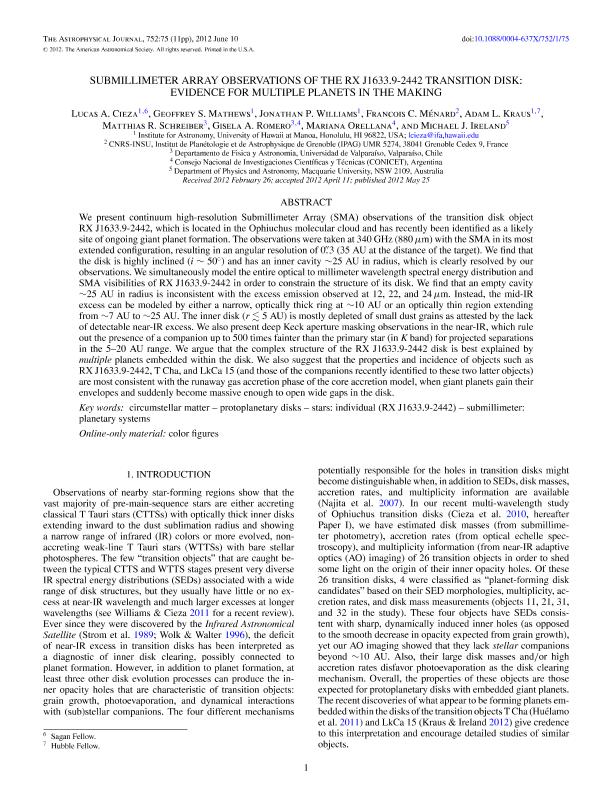Artículo
Submillimeter array observations of the RX J1633.9-2442 transition disk: evidence for multiple planets in the making
Cieza, Lucas A.; Mathews, Geoffrey S.; Williams, Jonathan P.; Menard, Francois C.; Kraus, Adam L.; Schreiber, Matthias R.; Romero, Gisela Andrea ; Orellana, Mariana Dominga
; Orellana, Mariana Dominga ; Ireland, Michael J.
; Ireland, Michael J.
 ; Orellana, Mariana Dominga
; Orellana, Mariana Dominga ; Ireland, Michael J.
; Ireland, Michael J.
Fecha de publicación:
06/2012
Editorial:
Iop Publishing
Revista:
Astrophysical Journal
ISSN:
0004-637X
Idioma:
Inglés
Tipo de recurso:
Artículo publicado
Clasificación temática:
Resumen
We present continuum high-resolution Submillimeter Array (SMA) observations of the transition disk object RX J1633.9-2442, which is located in the Ophiuchus molecular cloud and has recently been identified as a likely site of ongoing giant planet formation. The observations were taken at 340 GHz (880 μm) with the SMA in its most extended configuration, resulting in an angular resolution of 0.3arcsec (35 AU at the distance of the target). We find that the disk is highly inclined (i ~ 50°) and has an inner cavity ~25 AU in radius, which is clearly resolved by our observations. We simultaneously model the entire optical to millimeter wavelength spectral energy distribution and SMA visibilities of RX J1633.9-2442 in order to constrain the structure of its disk. We find that an empty cavity ~25 AU in radius is inconsistent with the excess emission observed at 12, 22, and 24 μm. Instead, the mid-IR excess can be modeled by either a narrow, optically thick ring at ~10 AU or an optically thin region extending from ~7 AU to ~25 AU. The inner disk is mostly depleted of small dust grains as attested by the lack of detectable near-IR excess. We also present deep Keck aperture masking observations in the near-IR, which rule out the presence of a companion up to 500 times fainter than the primary star (in K band) for projected separations in the 5-20 AU range. We argue that the complex structure of the RX J1633.9-2442 disk is best explained by multiple planets embedded within the disk. We also suggest that the properties and incidence of objects such as RX J1633.9-2442, T Cha, and LkCa 15 (and those of the companions recently identified to these two latter objects) are most consistent with the runaway gas accretion phase of the core accretion model, when giant planets gain their envelopes and suddenly become massive enough to open wide gaps in the disk.
Archivos asociados
Licencia
Identificadores
Colecciones
Articulos(CCT - LA PLATA)
Articulos de CTRO.CIENTIFICO TECNOL.CONICET - LA PLATA
Articulos de CTRO.CIENTIFICO TECNOL.CONICET - LA PLATA
Articulos(IAR)
Articulos de INST.ARG.DE RADIOASTRONOMIA (I)
Articulos de INST.ARG.DE RADIOASTRONOMIA (I)
Citación
Cieza, Lucas A.; Mathews, Geoffrey S.; Williams, Jonathan P.; Menard, Francois C.; Kraus, Adam L.; et al.; Submillimeter array observations of the RX J1633.9-2442 transition disk: evidence for multiple planets in the making; Iop Publishing; Astrophysical Journal; 752; 1; 6-2012; 75-86
Compartir
Altmétricas



